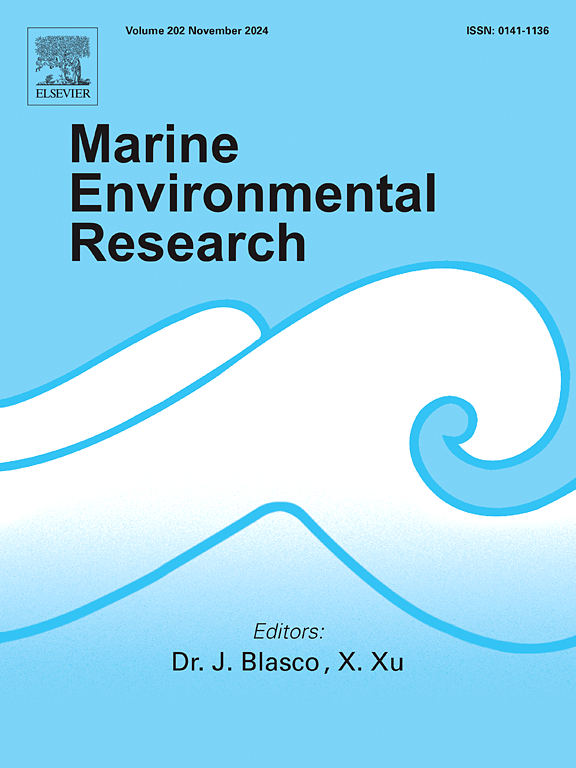为什么不在波浪作用的地方更大一些呢?寄居蟹体型的能量限制
IF 3
3区 环境科学与生态学
Q2 ENVIRONMENTAL SCIENCES
引用次数: 0
摘要
应对波浪作用需要大量的能量。因此,暴露在海浪中的动物的耐力应该取决于能量摄入和承受海浪所需的能量之间的长期平衡。由于升力和阻力的水动力随体型的增大而增大,我们预计在波浪暴露区域会发现体型较小的个体。我们对寄居蟹的体型分布沿波浪作用强度的梯度进行了采样。然后,我们通过实验估计了在两种不同强度的双向水流中暴露21天的个体的能量收支(同化能量、维持代谢率和应对波浪的成本)与体型的关系。根据Sebens模型,利用吸收能量指数和应对波浪的能量成本指数计算理论预测的最佳和最大能量大小。我们发现,应对波浪的成本随着波浪强度和体型的增加而增加,因为生理维持和附着在基质上的能量需求更高。虽然在两种波的情况下,吸收的能量随着体型的增加而增加,但与在弱波处理下的个体相比,在强波处理下的个体中,这种增加不那么明显。此外,在较强的实验波态下,能量约束随体尺寸的增加而增加,并且现场收集的个体小于模型在类似波态下预测的最大尺寸。总之,这些结果表明寄居蟹可能表现出一种适应性的次极大生长策略,以减轻波浪作用的水动力成本。本文章由计算机程序翻译,如有差异,请以英文原文为准。

Why not be larger in wave action sites? Energetic constraints due to body size in hermit crabs
Coping with wave action is energetically demanding. Therefore, the endurance of animals exposed to waves should depend on a long-term balance between energy intake and the energy needed to withstand waves. Since the hydrodynamic forces of lift and drag increase with body size, we expected to find smaller individuals in wave-exposed areas. We sampled the body size distribution of hermit crabs along a gradient of wave action intensity. Then, we experimentally estimated energy budget (assimilated energy, maintenance metabolic rate, and the cost of coping with waves) as a function of body size in individuals exposed to bidirectional water flow at two different intensities for 21 days. We used the exponents of the assimilated energy and of the energetic cost of coping with waves to compute the theoretically predicted optimum and maximum energetic size according to the Sebens model. We found that the cost of coping with waves increased with wave intensity and body size due to the higher energetic demands of physiological maintenance and of remaining attached to the substrate. Although assimilated energy increased with body size under both wave regimes, this increase was less pronounced in the individuals exposed to the stronger wave regime compared to those in the weaker wave treatment. Furthermore, under the stronger experimental wave regime energetic constraints increased with body size, and individuals collected in the field were smaller than the maximum size predicted by the model for a similar wave regime. Together, these results suggest that hermit crabs may exhibit an adaptive submaximal growth strategy to mitigate the hydrodynamic costs of wave action.
求助全文
通过发布文献求助,成功后即可免费获取论文全文。
去求助
来源期刊

Marine environmental research
环境科学-毒理学
CiteScore
5.90
自引率
3.00%
发文量
217
审稿时长
46 days
期刊介绍:
Marine Environmental Research publishes original research papers on chemical, physical, and biological interactions in the oceans and coastal waters. The journal serves as a forum for new information on biology, chemistry, and toxicology and syntheses that advance understanding of marine environmental processes.
Submission of multidisciplinary studies is encouraged. Studies that utilize experimental approaches to clarify the roles of anthropogenic and natural causes of changes in marine ecosystems are especially welcome, as are those studies that represent new developments of a theoretical or conceptual aspect of marine science. All papers published in this journal are reviewed by qualified peers prior to acceptance and publication. Examples of topics considered to be appropriate for the journal include, but are not limited to, the following:
– The extent, persistence, and consequences of change and the recovery from such change in natural marine systems
– The biochemical, physiological, and ecological consequences of contaminants to marine organisms and ecosystems
– The biogeochemistry of naturally occurring and anthropogenic substances
– Models that describe and predict the above processes
– Monitoring studies, to the extent that their results provide new information on functional processes
– Methodological papers describing improved quantitative techniques for the marine sciences.
 求助内容:
求助内容: 应助结果提醒方式:
应助结果提醒方式:


